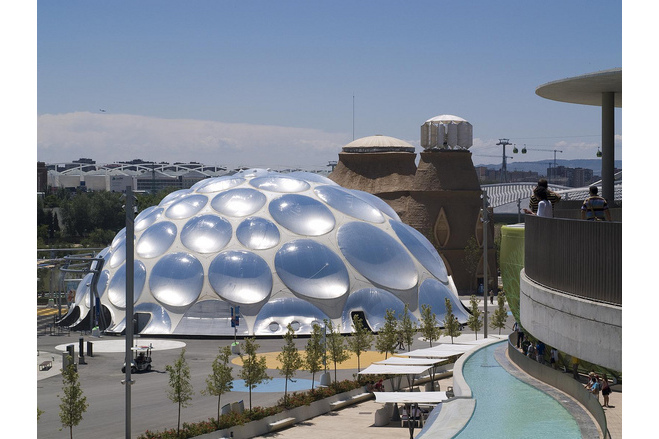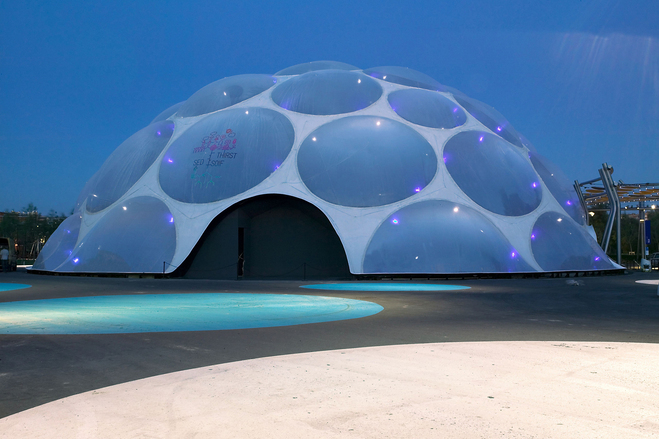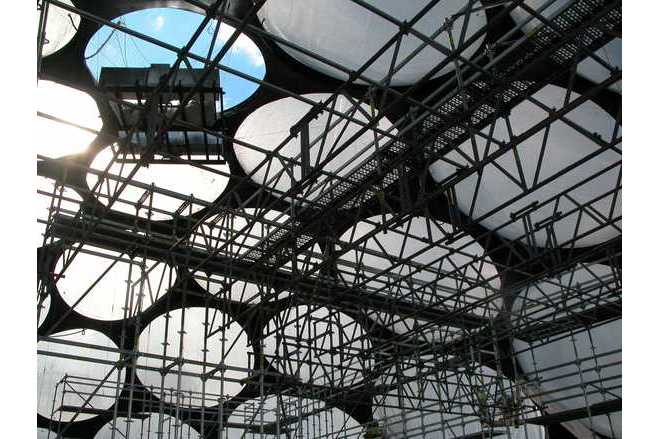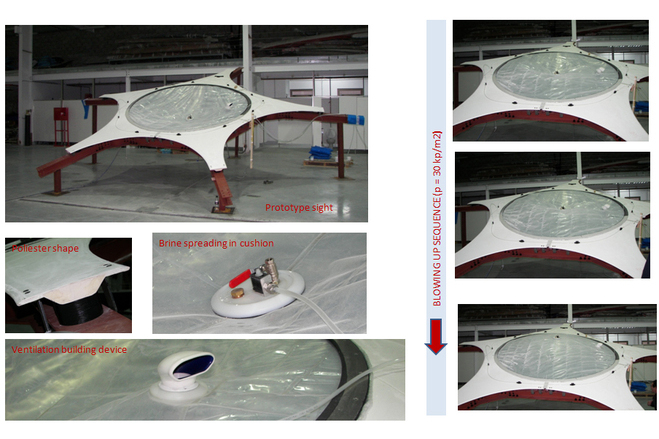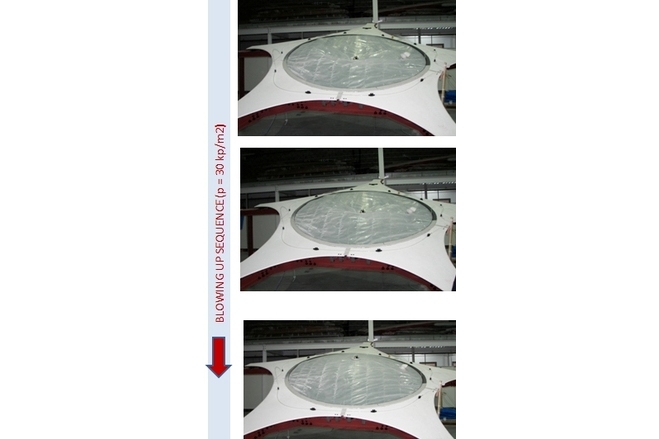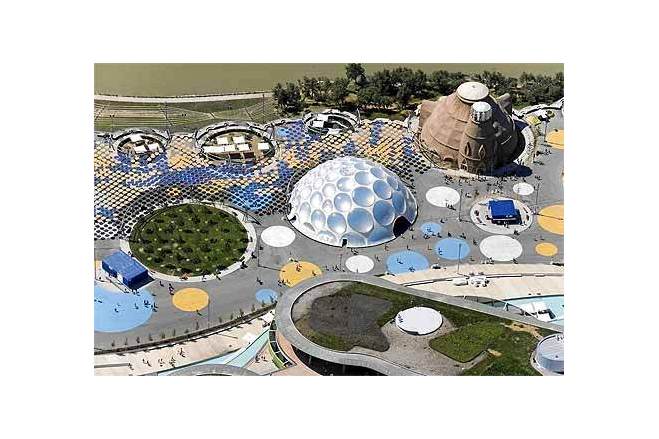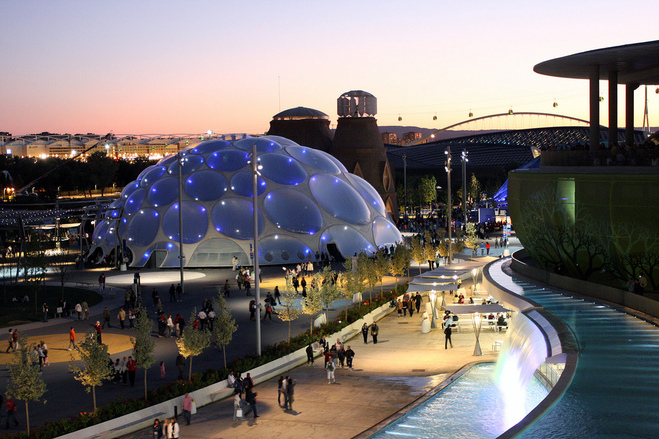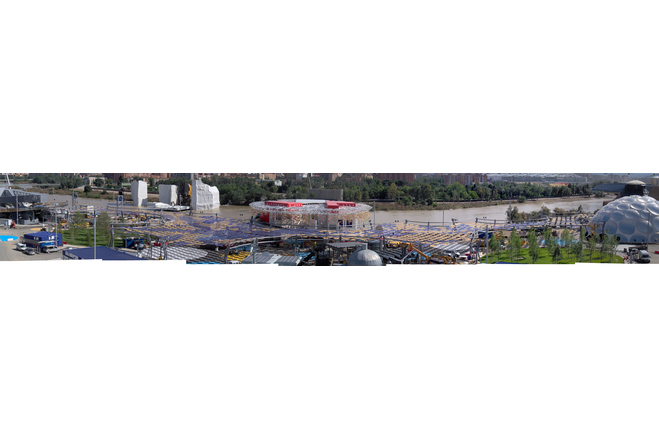Thirst pavilion for International Expo “water and sustainable development”
General information
-
Home page
www.arquitextil.net
-
Location address
ExpoZaragoza fairground, Saragossa
-
Location country
Spain
-
Name of the client/building owner
Expo Zaragoza 2008
-
Function of building
Exhibition
-
Degree of enclosure
Fully enclosed structure
-
Climatic zone
Mediterranean - mild winters, dry hot summers
-
Number of layers
double-layer
-
Type of application of the membrane
covering
-
Primary function of the tensile structure
- Space defining elements
Description
Idea
The International Expo “Water and Sustainable Development” that took place in Saragossa during the summer of 2008 in the Ebro’s banks required the creation of buildings for housing the exhibition contents.
One of these buildings was the Thirst Pavilion, located in the Expo area named Thematic Plazas, which mission was to transmit the need of water for the humankind and the consequences suffered by the environment for satisfying that need. For reach such objective, architect Enric Ruiz-Geli, conceived the building as an enclosed building, a spherical segment of 46m diameter in plan, having a height of 16m, remembering a big morula, being externally composed its skin by a macro “porosity” reticule of reinforced fiberglass polyester shells, being those “pores” filled by means of EFTE cushions.
Construction of the pavilion
In base to the Basic Project, Expo published the competition for the construction of the Pavilion, which was adjudicated to the Contractor Ferrovial, but they haven’t got the properly knowledge to afford the construction of the polyester shell and EFTE cushions, so they subcontracted Comercial Marítima for such building jobs. Due to the degree of development of the project, it was needed the help of detailing engineering assistance in polyester shells and ETFE cushions for building the Pavilion, which was made by Arenas&Asociados. The Polyester Shells could be manufactured thanks to the sailing contacts between José María Lastra (Comercial Marítima) and Francisco Abeledo (Hércules Marine), who could manage to get all the shells on time. It must be said that another Polyester manufacturer had abandoned the project a few months before the Expo Opening and the Pavilion was in a serious danger of not had been built.
EFTE cushions
EFTE cushions appeared in the project as an idea, but they weren’t defined, so they required a detailing engineering job, made by Arenas&Asociados, who subsequently submitted to Comercial Marítima the data needed for patterning and manufacturing. The Pavilion had 82 two layered ETFE cushions, having different dimensions all of them. It could be said that they had “circular” section, varying their diameter between 2.8m and 9.8m, but maintaining always a rate sag/diameter of 0.15 for each of the two layers of the cushion. The size of the cushions decreased from bottom of the building to top helicoidally. As previously was said, the cushions were composed by two layers, having both a thickness of 200mm, being the external transparent and silvered the inner one. Due to the silvered coating, the sun rays were reflected, providing to the Pavilion an interesting appearance of a set of water drops. Inside the cushions, leds diodes were installed for night illumination, blue and white were the colors selected. Three sets of seven diodes, two blue and one white were introduced in each cushions. At night, a global blue radiosity in the Pavilion was achieved thanks to the silvered layer because it reflected the led’s lights. Furthermore, the initial idea was covering the Pavilion with a salt crust of 5cm of thickness, and for that reason the cushions were provided with brine water vaporizers, but at last, during the Expo, the salt didn’t grip properly in the external ETFE layer and the water vaporization was forgotten. For gripping the salt on the external ETFE surface was needed the application of a latex gel, but this solution lost the transparency of the ETFE, making it translucent, and hindering the light reflection in the silvered layer. The cushions were inflated with an internal pressure of 30kp/m2 (3mbar) which allowed them resisting all the external actions, wind and snow according to the local codes, without having slackening or stresses higher than 21N/mm2 in any of the cushions layers. Controlling the stresses, the strain is controlled, avoiding the high plastic behavior of the ETFE.
Glass reinforced polyester shells
The Pavilion skin, with the ETFE cushions, was completed with white reinforced glass polyester shells, contrasting the whiteness of the shells with the brightness of the cushions.
Each shell was a segment of the spherical envelope of the Pavilion, covering the holes that the cushions didn’t fill, limiting with three cushions and having three axes forming 120º between them.
Manufactured by Hercules Marine, each shell had a global thickness of 48mm, with an upper layer of 5mm, a lower of 3mm and a middle one of 40mm. The external layers were composites, fiberglass reinforced polyester, with 40% of biaxial fibers of 600g/m2. The inner layer was composed by polyurethane foam, lightening the shell. The thicker upper layer was for resisting external loads acting directly over the surface. These shells had a great importance; because they bear the reactions transferred by the ETFE cushions and transmitted those reactions and the loads acting over them to the supporting steel frame by means of three EPDM bearings located in the shell vertices. Concerning to the force transmission between cushions and shells, Arenas&Asociados studied that phenomena, designing the polyester edge, a rigid composite of fiberglass reinforced polyester of 13mm of thickness and 60mm length. In this edge, the aluminium cushion frame was bolted to the polyester. At last, this rigid union wasn’t enough adequate, because it stiffness wasn’t able to afford the big geometrical imperfections registered in the construction of steel frame structure, which had collapsed during its erection for a badly proposed stage construction, due to a bad engineering study by the steel contractor, who didn’t understand that a shell structure works properly when it is finished, it must be said, when forces follow form, but in the staged construction, provisional bearings are needed and they were almost neglected.
This error damaged some elements that even weren’t replaced, only the bolts, and delayed the time for finishing the building works, but at last it was possible to finish in time. Added to the geometrical imperfections we have to take into account the thermal effects, but they were considered dividing the aluminium steel frame in segments. Those geometrical problems caused the failure of some ETFE cushions, because its geometry couldn’t fit the hole where they must be installed. Finally, thanks to the efforts of José María Lastra, and his interest in achieving a perfect result, he re-patterned the cushions with geometrical problems until they fit correctly. As conclusion, flexible connections based in neoprene are better than rigid unions.
Real scale Model
Due to the complexity of the project, the Property and the Architect, asked for a real scale model, which was made by Comercial Marítima, Hércules Marine, and the engineering support of Arenas&Asociados. In Hércules Marine’s workshop a real scale model of one cushion was made. The model included the steel frame support, the polyester shells and the ETFE cushion with its aluminium frame, led illumination and brine water vaporizer. It was inflated to the service pressure, 30kp/m2 (3mbar), being the model successful, and permitting to obtain conclusions such deciding not applying the latex gel for salt gripping for achieving a better transparency in the external ETFE layer, or painting in white the aluminium cushion frame.
Conclusion
Despite of the success achieved by the Pavilion architecture, it was decided by the Expo Authorities that it would have to be dismantled, what was already done; but it is going to be rebuilt in Valladolid by Aldesa, who bought it.
Description of the environmental conditions
Material of the cover
-
Material Fabric/Foil
ETFE-foil
Main dimensions and form
-
Covered surface (m2)
1662
-
Maximum height (m)
16
-
Form single element
Monoclastic
-
Form entire structure
Monoclastic
Duration of use
-
Temporary or permanent structure
Permanent
-
Convertible or mobile
Convertible and mobile
Involved companies
-
Architects
Enric Ruiz-Geli (Cloud 9)
-
Engineers
Santiago Guerra Soto & Guillermo Capellán Miguel
-
Contractors
Ferrovial
Editor
-
Editor
Evi Corne


